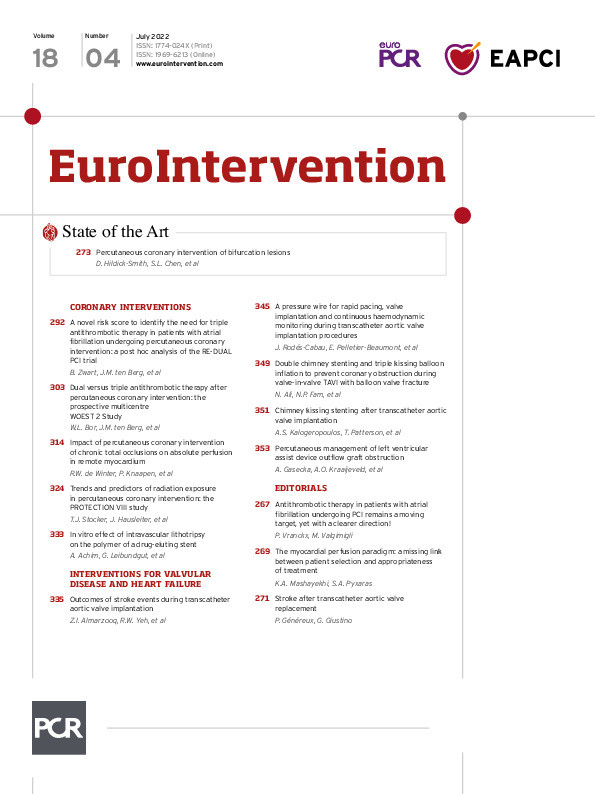Despite recent advances in techniques and materials used, the treatment of coronary chronic total occlusion (CTO) remains the most complex scenario for percutaneous coronary intervention (PCI). Evidence-based findings suggest that in patients affected by chronic coronary syndrome, a successful CTO-recanalisation offers an improvement in quality of life versus medical treatment alone1. In terms of “hard” clinical endpoints, however, the potential benefits of CTO-PCI, as previously seen in retrospective series and meta-analyses23, have not yet been confirmed by randomised trials14. Among other implicit limitations (e.g., low enrolment rates, study designs underpowered to detect clinical benefits etc.), patient selection remains a key issue in assessing the potential impact of CTO-PCI on clinical outcome. Focusing on the patient subgroup that will likely benefit the most from CTO-PCI (namely, symptomatic patients with hibernating myocardium or conserved myocardial viability and evidence of stress-induced ischaemia) seems to be the next necessary step to push the envelope further in this field.
Cardiac positron emission tomography (PET) is an ideal non-invasive diagnostic method that offers invaluable insights into both the occluded vessel- and donor vessel-related myocardium, and also accounts for complex interactions between subepicardial and subendocardial perfusions, microvascular dysfunction, and absolute flow5. Indeed, in this issue of EuroIntervention, de Winter et al6 present a landmark study in this direction.
The authors enrolled a series of 164 patients, all of them undergoing serial [15O]H2O PET perfusion imaging at baseline and at three months after successful single-vessel CTO-PCI6. Their findings suggest an improvement in remote myocardial perfusion following CTO-PCI, showing an increase in the values of hyperaemic myocardial blood flow (hMBF) (from 2.29±0.67 to 2.48±0.75 mL·min–1·g–1; p<0.01) and coronary flow reserve (CFR; from 2.48±0.76 to 2.74±0.85; p<0.01). Furthermore, the expected increase in hMBF and CFR of the CTO-subtended myocardium was independently associated with the absolute perfusion increase observed in the remote myocardium, confirming the substantial interplay between otherwise “artificially” divided myocardial regions.
For the sake of clarity, some necessary comments regarding the interpretation of their findings should be made. First, in contrast with the current suggested definition of CTO7, the study’s definition of CTO also includes vessels that have a Thrombolysis in Myocardial Infarction (TIMI) flow I. Despite the prevalence of a rather large collateral circulation (collateral connection grade 2 in 72% of cases), implying the absence of a haemodynamically relevant antegrade flow, some caution should be taken before translating these findings to the global CTO patient population. Second, the relatively high proportion of included patients with prior PCI (74%) suggests that in these cases the donor vessel is also likely to be diffusely atherosclerotic. The abnormal conductance of the latter may account – at least to some extent - for the significant increase in remote myocardial perfusion after CTO-PCI8. Likewise, it is unlikely that microcirculation plays a significant role, considering that the so-called “steal-phenomenon” is to be attributed to flow/pressure differences between subepicardial and subendocardial perfusions, rather than abnormalities in microvasculature. Of note, an increase in hMBF after recanalisation of the occluded artery suggests a rather normal function of the microcirculation. Third, the left ventricular ejection fraction (LVEF) values in the patient population were predominantly normal, precluding meaningful conclusions regarding the potential impact of CTO-recanalisation on improving myocardial functionality. Considering the overall improvement in myocardial perfusion following successful CTO-PCI, as documented in the present paper, a study enrolling patients with compromised LVEF may shed some light on myocardial perfusion variations in CTO patient subsets of particular interest (e.g., presence of large areas of hibernating myocardium)9. Fourth, the rate of patients included with angina is lower than expected considering that the main clinical benefit of such a procedure concerns anginal status1. Whether other categories of clinical presentation can be recognised as “anginal equivalents” is unclear. Again, patient selection based on clinical status other than angiographic characteristics would probably have improved the interpretability of the study findings in relation to the real-world CTO patient population.
All in all, the findings of this study highlight the importance of proper patient selection based on a non-invasive diagnostic assessment of myocardial flow combined with anatomic characteristics. Shifting the paradigm towards patient populations that will significantly benefit from CTO-PCI is the necessary next step toward acquiring convincing evidence-based data that may potentially translate to clinical benefits.
Conflict of interest statement
K. A. Mashayekhi received consultancy fees and speaker honoraria from Abbott, Abiomed, Asahi Intecc, AstraZeneca, Biotronik, Boston Scientific, Cardinal Health, Daiichi Sankyo, Medtronic, Shockwave, SIS Medical, Teleflex, and Terumo. S. A. Pyxaras reports proctorship and consultancy fees from Asahi Intecc and Boston Scientific, and speaker honoraria from Abiomed, AstraZeneca and Biotronik.
Supplementary data
To read the full content of this article, please download the PDF.

